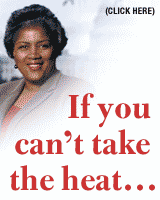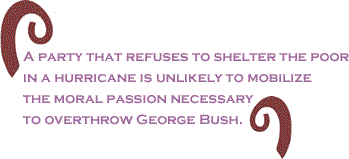
|
|||||||||||||||||||||
This article originally appeared in TomDispatch.com, a project of The Nation Institute. The evacuation of New Orleans in the face of Hurricane Ivan looked sinisterly like Strom Thurmond's version of the Rapture. Affluent white people fled the Big Easy in their SUVs, while the old and car-less – mainly Black – were left behind in their below-sea-level shotgun shacks and aging tenements to face the watery wrath. New Orleans had spent decades preparing for inevitable submersion by the storm surge of a class-five hurricane. Civil defense officials conceded they had ten thousand body bags on hand to deal with the worst-case scenario. But no one seemed to have bothered to devise a plan to evacuate the city's poorest or most infirm residents. The day before the hurricane hit the Gulf Coast, New Orlean's daily, the Times-Picayune, ran an alarming story about the "large group…mostly concentrated in poorer neighborhoods" who wanted to evacuate but couldn't. Only at the last moment, with winds churning Lake Pontchartrain, did Mayor Ray Nagin reluctantly open the Louisiana Superdome and a few schools to desperate residents. He was reportedly worried that lower-class refugees might damage or graffiti the Superdome. In the event, Ivan the Terrible spared New Orleans, but official callousness toward poor Black folk endures.
Over the last generation, City Hall and its entourage of powerful developers have relentlessly attempted to push the poorest segment of the population – blamed for the city's high crime rates – across the Mississippi river. Historic Black public-housing projects have been razed to make room for upper-income townhouses and a Wal-Mart. In other housing projects, residents are routinely evicted for offenses as trivial as their children's curfew violations. The ultimate goal seems to be a tourist theme-park New Orleans – one big Garden District – with chronic poverty hidden away in bayous, trailer parks and prisons outside the city limits. But New Orleans isn't the only case-study in what Nixonians once called "the politics of benign neglect." In Los Angeles, county supervisors have just announced the closure of the trauma center at Martin Luther King Jr. Hospital near Watts. The hospital, located in the epicenter of LA's gang wars, is one of the nation's busiest centers for the treatment of gunshot wounds. The loss of its ER, according to paramedics, could "add as much as 30 minutes in transport time to other facilities." The result, almost certainly, will be a spate of avoidable deaths. But then again the victims will be Black or Brown and poor.
On the fiftieth anniversary of the 1964 Civil Rights Act, the United States seems to have returned to degree zero of moral concern for the majority of descendants of slavery and segregation. Whether the Black poor live or die seems to merit only haughty disinterest and indifference. Indeed, in terms of the life-and-death issues that matter most to African-Americans – structural unemployment, race-based super-incarceration, police brutality, disappearing affirmative action programs, and failing schools – the present presidential election might as well be taking place in the 1920s.
The DLC, of course, has long yearned to bring white guys and fat cats back to a Nixonized Democratic Party. Arguing that race had fatally divided Democrats, the DLC has tried to bleach the Party by marginalizing civil rights agendas and Black leadership. African-Americans, it is cynically assumed, will remain loyal to the Democrats regardless of the treasons committed against them. They are, in effect, hostages. Thus the sordid spectacle – portrayed in Fahrenheit 9/11 – of white Democratic senators refusing to raise a single hand in support of the Black Congressional Caucus's courageous challenge to the stolen election of November 2000. The Kerry campaign, meanwhile, steers a straight DLC course toward oblivion. No Democratic presidential candidate since Eugene McCarthy's run in 1968 has shown such patrician disdain for the Democrats' most loyal and fundamental social base. While Condoleezza Rice hovers, a tight-lipped and constant presence at Dubya's side, the highest ranking, self-proclaimed "African American" in the Kerry camp is Teresa Heinz ((born and raised in white-colonial privilege).
This crude joke has been compounded by Kerry's semi-suicidal reluctance to mobilize Black voters. As Rainbow Coalition veterans like Ron Waters have bitterly pointed out, Kerry has been absolutely churlish about financing voter registration drives in African-American communities. Ralph Nader – I fear – was cruelly accurate when he warned recently that "the Democrats do not win when they do not have Jesse Jackson and African Americans in the core of the campaign." In truth, Kerry, the erstwhile war hero, is running away as hard as he can from the sound of the cannons, whether in Iraq or in America's equally ravaged inner cities. The urgent domestic issue, of course, is unspeakable socio-economic inequality, newly deepened by fiscal plunder and catastrophic plant closures. But inequality still has a predominant color, or, rather, colors: black and brown. Kerry's apathetic and uncharismatic attitude toward people of color will not be repaired by last-minute speeches or campaign staff appointments. Nor will it be compensated for by his super-ardent efforts to woo Reagan Democrats and white males with war stories from the ancient Mekong Delta. A party that in every real and figurative sense refuses to shelter the poor in a hurricane is unlikely to mobilize the moral passion necessary to overthrow George Bush, the most hated man on earth. Mike Davis is the author of Dead Cities: And Other Tales as well as Ecology of Fear and co-author of Under the Perfect Sun: the San Diego Tourists Never See, among other books. |
| September30 2004 Issue 107 |
|||||||||
|
|||||||||
|
|
|||||||||
| Printer Friendly Version | |||||||||
 |
|||||||||
 |
|||||||||
 |
|||||||||
| |
|||||||||
| |
|||||||||



























